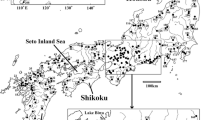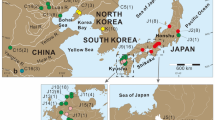Abstract
Many straits in the Japanese archipelago have been proposed as biogeographical boundaries, but there is disagreement regarding their importance as historic barriers against dispersal of terrestrial and freshwater taxa. Mitochondrial DNA haplotype and phylogenetic analyses of Lefua nikkonis, a primary freshwater fish inhabiting northern Japan and descendent from Siberia, revealed that the species is genetically structured within its geographic range, but that two major haplotypes are widely distributed across the Ishikari Lowland of Hokkaido Island as well as across the Tsugaru Strait between Hokkaido and Honshu Islands, two well-known biogeographical boundaries of northern Japan. The two major haplotypes were separated from each other by only one mutational step, and many other haplotypes, including those endemic to the region south of these barriers, have diverged from the major haplotypes, suggesting rapid range expansion and local differentiation. Divergence-time estimates, based on vicariance of the Honshu endemic congener L. echigonia via uplift of the Central Highlands, demonstrated that the southward dispersal of L. nikkonis from Hokkaido Island to Honshu Island occurred less than 0.08–0.19 Mya, suggesting that a land bridge emerged at the Tsugaru Strait during the Riss glaciation. Given that other freshwater taxa crossed the strait earlier (during the Middle Pleistocene), it is likely that land bridges in the strait have repeatedly emerged. The fact that L. nikkonis invaded only the northern part of Honshu, and that many other freshwater species also have the limit of their distribution ranges in this area as well, indicates that a faunal transition zone might persist even without the Tsugaru Strait. Thus, straits and lowlands in northern Japan are likely to have been less important as dispersal barriers to freshwater taxa than is currently thought.





Similar content being viewed by others
References
Aoyagi H (1957) General notes on the freshwater fishes of the Japanese Archipelago. Taishukan, Tokyo
Blakiston T, Pryer H (1880) Catalogue of the birds of Japan. Trans Asiatic Soc Jpn 8:172–242
Clement M, Posada D, Crandall KA (2000) TCS: a computer program to estimate gene genealogies. Mol Ecol 9:1657–1659
Crandall KA, Templeton AR (1993) Empirical tests of some predictions from coalescent theory with applications to intraspecific phylogeny reconstruction. Genetics 134:959–969
Darriba D, Taboada GL, Doallo R, Posada D (2012) jModelTest 2: more models, new heuristics and parallel computing. Nat Methods 9:772
Drummond AJ, Rambaut A (2007) BEAST: Bayesian evolutionary analysis by sampling trees. BMC Evol Biol 7:214
Fujimaki Y (1994) Across the strait: fauna of mixture. In: Ishigaki K, Fukuda M (eds) Formation history of nature of Hokkaido. Hokkaido University Press, Sapporo, pp 167–179
Goto A (1982) Freshwater fishes in Hokkaido and their origin. Tansuigyo 8:19–26
Goto A (1994) Fishes in rivers and lakes: origin and adaptive strategy. In: Ishigaki K, Fukuda M (eds) Formation history of nature of Hokkaido. Hokkaido University Press, Sapporo, pp 150–166
Goto A, Nakanishi T, Utoh H, Hamada K (1978) A preliminary study of the freshwater fish fauna of rivers in southern Hokkaido. Bull Fac Fish Hokkaido Univ 29:118–130
Japan Association for Quaternary Research (1987) Quaternary maps of Japan (plus explanatory text). University of Tokyo Press, Tokyo
Johnson KP, Weckstein JD (2011) The Central American land bridge as an engine of diversification in New World doves. J Biogeogr 38:1069–1076
Koizumi I, Usio N, Kawai T, Azuma N, Masuda R (2012) Loss of genetic diversity means loss of geological information: the endangered Japanese crayfish exhibits remarkable historical footprints. PLoS ONE 7:e33986
Kumar S, Stecher G, Tamura K (2016) MEGA7: molecular evolutionary genetics analysis version 7.0 for bigger datasets. Mol Biol Evol 33:1870–187
Kurose N, Masuda R, Yoshida MC (1999) Phylogeographic variation in two mustelines, the least weasel Mustela nivalis and the ermine M. erminea of Japan, based on mitochondrial DNA control region sequences. Zool Sci 16:971–977
Kuwahara T (1996) The geographic distribution and reproductive biology of Lefua costata nikkonis. Master Theses, Faculty of Fisheries, Hokkaido University
Librado P, Rozas J (2009) DnaSP v5: a software for comprehensive analysis of DNA polymorphism data. Bioinformatics 25:1451–1452
Machida H, Matsuda T, Umitsu M, Koizumi T (2006) Regional geomorphology of the Japanese islands, vol 5. Geomorphology of Chubu Region. University of Tokyo Press, Tokyo
Masuda H, Amaoka K, Araga C, Uyeno T, Yoshino T (1988) The Fishes of the Japanese Archipelago, English edition. Tokai University Press, Tokyo
Matsui H, Tada R, Oba T (1998) Low-salinity isolation event in the Japan Sea in response to eustatic sea-level drop during LGM: reconstruction based on salinity-balance model. Daiyonki Kenkyu (Quaternary Res) 37:221–233
Ministry of the Environment, Government of Japan (2012) The 4th version of the Japanese red lists. Ministry of the Environment, Government of Japan, Tokyo
Miyazaki J, Dobashi M, Tamura T, Beppu S, Sakai T, Mihara M, Hosoya K (2011) Parallel evolution in eight-barbel loaches of the genus Lefua (Balitoridae, Cypriniformes) revealed by mitochondrial and nuclear DNA phylogenies. Mol Phylogenet Evol 60:416–417
Mayr E (1944) Wallace’s Line in the light of recent zoogeographic studies. Q Rev Biol 19:1–14
Nakajima J (2017) Loaches of Japan–natural history and culture. Yama-kei Publishers, Tokyo
von Oheimb PV, Albrecht C, Riedel F, Bössneck U, Zhang H, Wilke T (2013) Testing the role of the Himalaya Mountains as a dispersal barrier in freshwater gastropods (Gyraulus spp.). Biol J Linn Soc 109:526–53
Ohshima K (1990) The history of straits around the Japanese Island in the late-Quaternary. Daiyonki Kenkyu (Quaternary Res) 29:193–208
Ohshima K (1991) The late-Quaternary sea-level change of the Japanese islands. J Geogr 100:967–975
Ohtani K, Kido K (1980) Oceanographic Structure in Funka Bay. Bull Fac Fish Hokkaido Univ 31:84–114
Ono Y (1994) A drama in the ice age: the genesis of Hokkaido. In: Ishigaki K, Fukuda M (eds) Formation history of nature of Hokkaido. Hokkaido University Press, Sapporo, pp 1–15
Ooyagi A (2013) Distribution in the Shimokita Peninsula, Aomori Prefecture of Japanese Ezohotoke Lefua nikkonis (Cobitidae) and morphologic comparison with species of the Hokkaido Prefecture product. J Nat Hist Aomori 18:61–67
Parenti LR, Ebach MC (2009) Comparative biogeography: discovering and classifying biogeographical patterns of a dynamic earth. University of California Press, Oakland
Ronquist F, Teslenko M, van der Mark P, Ayres D, Darling A, Höhna S, Larget B, Liu L, Suchard MA, Huelsenbeck JP (2011) MrBayes 3.2: Efficient Bayesian phylogenetic inference and model choice across a large model space. Syst Biol 61:1–4
Saka R, Takehana Y, Suguro N, Sakaizumi M (2003) Genetic population structure of Lefua echigonia inferred from allozymic and mitochondrial cytochrome b variations. Ichthyol Res 50:301–309
Sakai H, Ueda T, Yokoyama R, Safronov SN, Goto A (2014) Genetic structure and phylogeography of northern Far Eastern pond minnows, Rhynchocypris perenurus sachalinensis and R. p. mantschuricus (Pisces, Cyprinidae), inferred from mitochondrial DNA sequences. Biogeography 16:87–109
Sato M (1969) Floristic and faunastic regions in biogeography. Ann Rep Inst Reg Stu Ibaraki Univ 1:7–27
Shedko SV, Miroshnichenko IL, Nemkova GA (2008) On the systematics and phylogeography of eight-barbel loaches of the genus Lefua (Cobitoidea: Nemacheilidae): mtDNA typing of L. pleskei. Russian J Genet 44:817–825
Silvestro D, Michalak I (2012) raxmlGUI: a graphical front-end for RAxML. Org Divers Evol 12:335–337
Takeuchi M, Ohta T (1993) Distribution and a few ecological aspects of Lefua costata nikkonis (Cobitididae) in Aomori Prefecture, Japan. Bull Biogeogr Soc Japan 48:73–80
Templeton AR, Sing CF (1993) A cladistic-analysis of phenotypic associations with haplotypes inferred from restriction endonuclease mapping. IV. Nested analyses with cladogram uncertainty and recombination. Genetics 134: 659–669
Tominaga K, Nakajima J, Watanabe K (2016) Cryptic divergence and phylogeography of the pike gudgeon Pseudogobio esocinus (Teleostei: Cyprinidae): a comprehensive case of freshwater phylogeography in Japan. Ichthyol Res 63:79–93
Wallace AR (1860) On the zoological geography of the Malay Archipelago. J Proc Linn Soc Lond Zool 4:172–184
Watanabe K, Takahashi H, Kitamura A, Yokoyama R, Kitagawa T, Takeshima H, Sato S, Yamamoto S, Takehana Y, Mukai T, Ohara K, Iguchi K (2006) Biogeographical history of Japanese freshwater fishes: phylogeographic approaches and perspectives. Jpn J Ichthyol 53:1–38
Watanabe K, Takahashi H (2010) Natural history of freshwater fish geography. Hokkaido University Press, Sapporo
Whitten AJ, Mustafa M, Henderson GS (2002) The ecology of Sulawesi. Periplus, Singapore
Yamazaki Y, Goto A, Nishida M (2003) Mitochondrial DNA sequence divergence between two cryptic species of Lethenteron, with reference to an improved identification technique. J Fish Biol 62:591–609
Yokoyama R, Goto A (2002) Phylogeography of a freshwater sculpin, Cottus nozawae, from the northeastern part of Honshu Island, Japan. Ichthyol Res 49:147–155
Acknowledgments
We thank Goto A, Kuwahara T, Miyazaki Y, Matsubara H, Miyazaki J, Koizumi I, Watanabe K, Takehana Y, Mukai T, Sakai T, Mishina T, Nakajima J, Takami Y, and Toda M for their valuable comments on this project. We also thank Yamaha E, Komazawa M, Takahashi H, Ichimura M, Azuma N, Takeda S, Kishida O, Mochida K, Ohbayashi K, Kanno T, Mori T, and Usui T for kindly helping with our field collections or for providing samples. This research was partially supported by a Kuromatsunai Biodiversity Conservation Research Grant to AO and KY.
Author information
Authors and Affiliations
Corresponding author
Electronic supplementary material
Below is the link to the electronic supplementary material.
About this article
Cite this article
Ooyagi, A., Mokodongan, D.F., Montenegro, J. et al. Phylogeography of the eight-barbel loach Lefua nikkonis (Cypriniformes: Nemacheilidae): how important were straits in northern Japan as biogeographical barriers?. Ichthyol Res 65, 115–126 (2018). https://doi.org/10.1007/s10228-017-0597-0
Received:
Revised:
Accepted:
Published:
Issue Date:
DOI: https://doi.org/10.1007/s10228-017-0597-0




